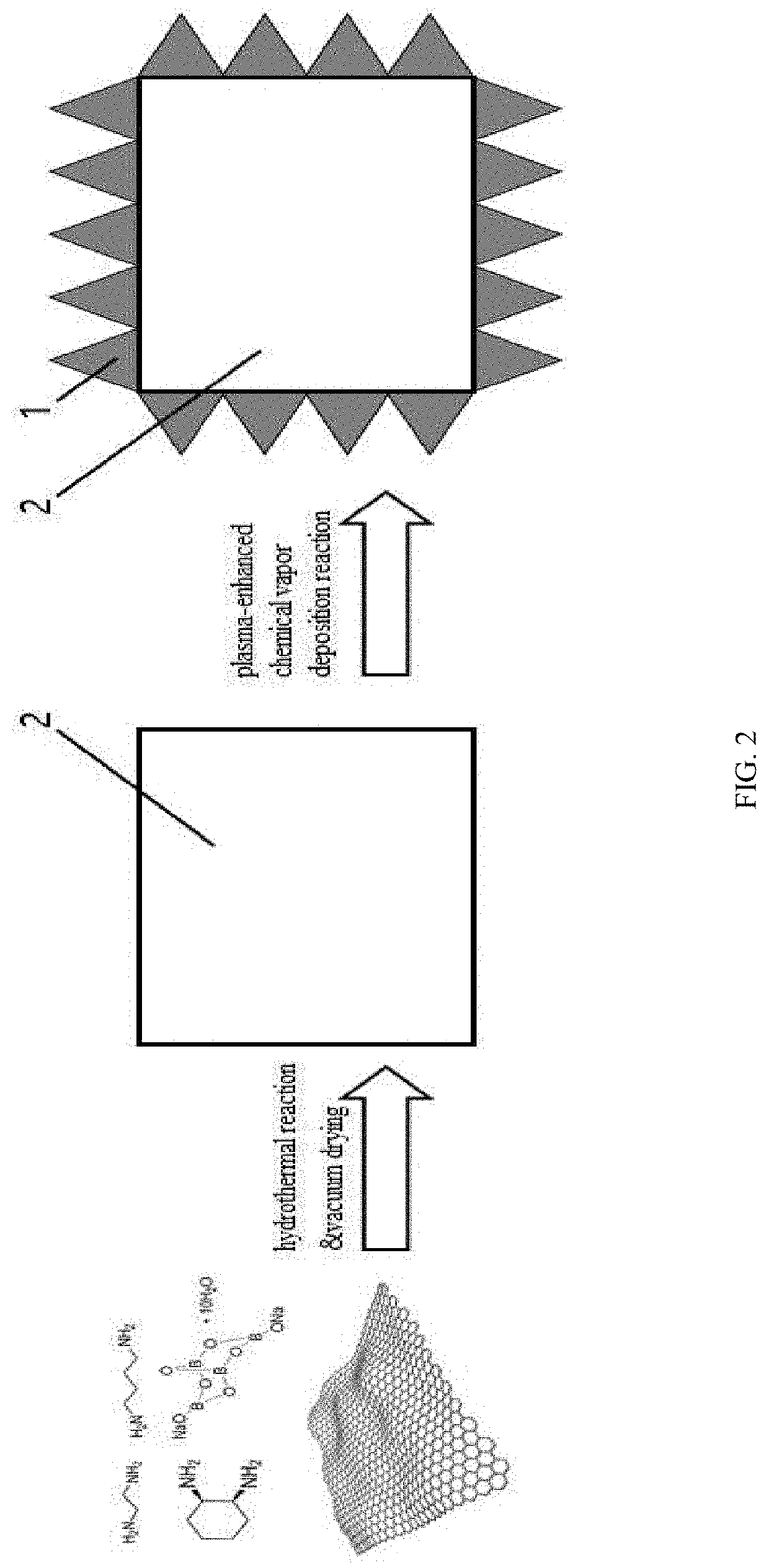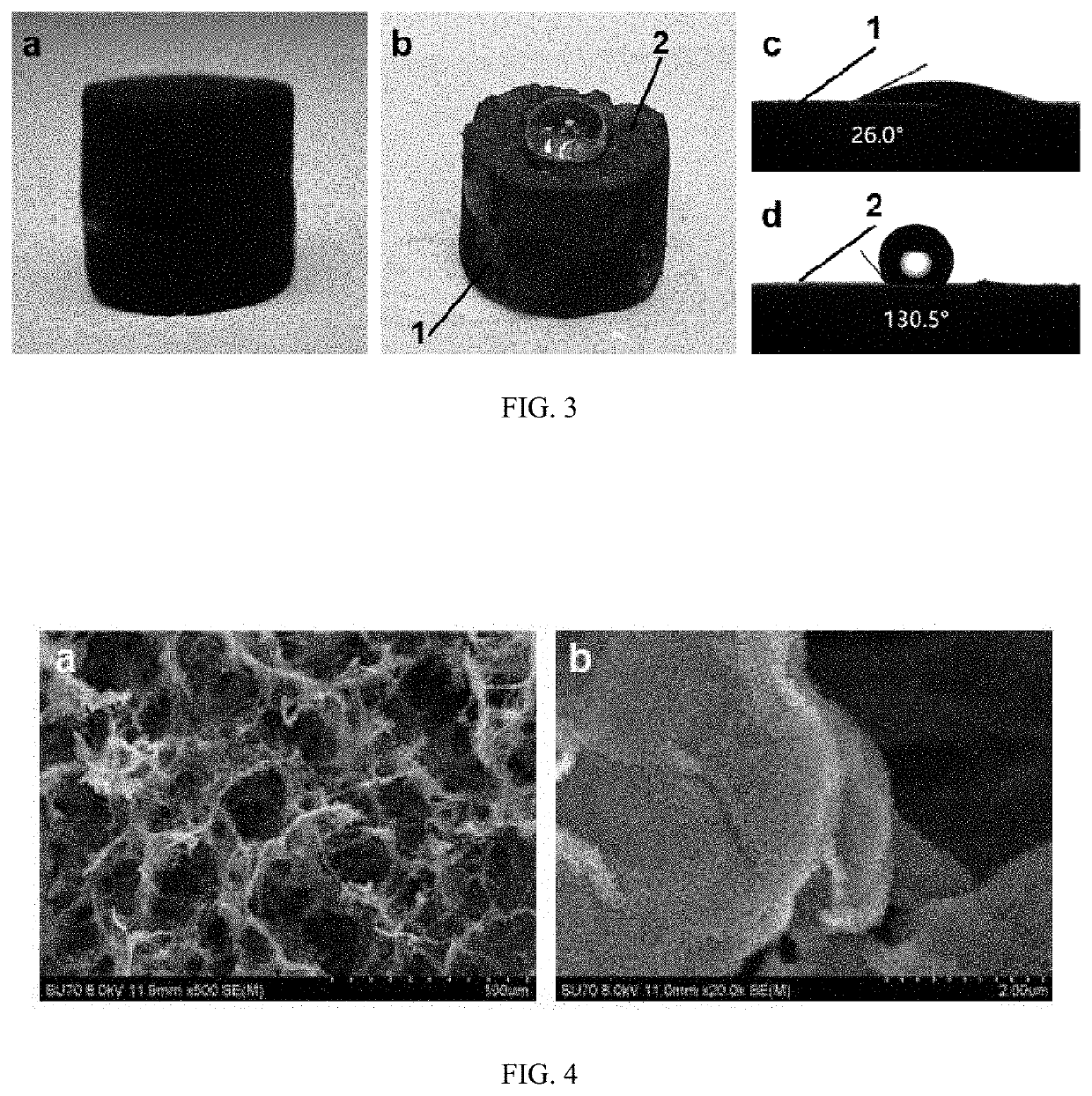Photothermal evaporation material integrating light absorption and thermal insulation, preparation application thereof, use thereof
a photothermal evaporation and light absorption technology, applied in the field of solar photothermal utilization, can solve the problems of reducing the mechanical stability of the system, deteriorating the thermal insulation performance of the localized heating system, and conducive to long-term operation, so as to improve the efficiency of photothermal conversion and improve the stability of the system. , the effect of preventing the loss of heat flow
- Summary
- Abstract
- Description
- Claims
- Application Information
AI Technical Summary
Benefits of technology
Problems solved by technology
Method used
Image
Examples
example 1
[0106]1. An aqueous solution of graphene oxide was provided, wherein the concentration of graphene oxide was 4 g L−1, the concentration of sodium tetraborate decahydrate was 1 mmol L−1, and the concentration of ethylenediamine was 4 mmol L−1.
[0107]2. The prepared aqueous solution of graphene oxide was transferred to a Teflon high temperature and high-pressure reactor, maintained at 90° C. for 6 hours, then maintained at 120° C. for 6 hours, and then cooled to room temperature to obtain a graphene hydrogel.
[0108]3. Soaking the obtained graphene hydrogel with ethanol aqueous solution for 6 hours, in which the volume fraction of ethanol was 10%, the purpose was to clean the additives remaining on the surface of the graphene hydrogel.
[0109]4. Transferring the washed graphene hydrogel to a freezing chamber with a temperature of −80° C., freezing for 6 hours, and then transferring to a drying chamber with a temperature of 0° C. and an air pressure of <650 Pa, and vacuum drying for 6 hours...
example 2
[0121]1. An aqueous solution of graphene oxide was provided, wherein the concentration of graphene oxide was 5 g L−1, the concentration of sodium tetraborate decahydrate was 2 mmol L−1, and the concentration of ethylenediamine was 8 mmol L−1.
[0122]2. The prepared aqueous solution of graphene oxide was transferred to a Teflon high temperature and high-pressure reactor, maintained at 120° C. for 12 hours, and then cooled to room temperature to obtain a graphene hydrogel.
[0123]3. Soaking the obtained graphene hydrogel with an ethanol aqueous solution for 12 hours, in which the volume fraction of ethanol was 20%, the purpose was to clean the additives remaining on the surface of the graphene hydrogel.
[0124]4. Transferring the washed graphene hydrogel to a freezing chamber with a temperature of −60° C., freezing for 12 hours, and then transferring it to a drying chamber at a temperature of −10° C. and an air pressure of <650 Pa, and vacuum drying for 12 hours to obtain a graphene foam.
[0...
example 3
[0131]1. An aqueous solution of graphene oxide was provided, wherein the concentration of graphene oxide was 5 g L−1, the concentration of sodium tetraborate decahydrate was 3 mmol L−1, and the concentration of ethylenediamine was 12 mmol L−1.
[0132]2. The prepared aqueous solution of graphene oxide was transferred to a Teflon high temperature and high-pressure reactor, maintained at 90° C. for 6 hours, then maintained at 180° C. for 6 hours, and finally, cooled to room temperature to obtain a graphene hydrogel.
[0133]3. Soaking the obtained graphene hydrogel with an ethanol aqueous solution for 18 hours, wherein the volume fraction of ethanol was 20%, the purpose was to clean the additives remaining on the surface of the graphene hydrogel.
[0134]4. Transferring the washed graphene hydrogel to a freezing chamber with a temperature of −40° C., freezing for 18 hours, and then transferring it to a drying chamber at a temperature of −10° C. and an air pressure of <650 Pa, and vacuum drying...
PUM
| Property | Measurement | Unit |
|---|---|---|
| Temperature | aaaaa | aaaaa |
| Temperature | aaaaa | aaaaa |
| Fraction | aaaaa | aaaaa |
Abstract
Description
Claims
Application Information
 Login to View More
Login to View More - R&D
- Intellectual Property
- Life Sciences
- Materials
- Tech Scout
- Unparalleled Data Quality
- Higher Quality Content
- 60% Fewer Hallucinations
Browse by: Latest US Patents, China's latest patents, Technical Efficacy Thesaurus, Application Domain, Technology Topic, Popular Technical Reports.
© 2025 PatSnap. All rights reserved.Legal|Privacy policy|Modern Slavery Act Transparency Statement|Sitemap|About US| Contact US: help@patsnap.com



